SureFire’s Barry Dueck discusses their various 5.56mm Suppressor offerings.
SureFire’s Barry Dueck discusses their various 5.56mm Suppressor offerings.
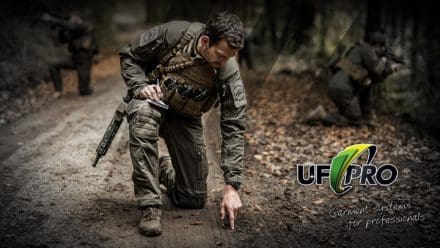
TRZIN, SLOVENIA (20 April 2020)—UF PRO, a maker of advanced tactical clothing for military and law-enforcement units in Europe and beyond, today announced it will debut on 27 April the first installment of a free, five-part video series teaching the latest tactical tracking techniques for apprehending crime suspects on the run.
The video series—titled “Pro’s Guide to Tactical Tracking”—follows former Dutch Royal Marine Boris Vos and his team of tactical trackers as they hunt down potential suspects., UF PRO said.
From episode to episode, Vos informs viewers about the newest ways of identifying and correctly analyzing the footprints, broken branches, campfire ashes, discarded items, and other telltale clues left by fleeing individuals, UF PRO said.
According to the company, tactical tracking using the latest techniques makes it possible to predict where vanished suspects will remerge and what escape routes they’ll likely use if they sense they’re about to be collared-and-cuffed.
“Tactical tracking is a high-level skill set that allows military personnel or law enforcers to gather visual indications of a suspect’s recent presence in or movement through an area and then correctly interpret what those indicators reveal,” UF PRO said.
UF PRO said each installment of “Pro’s Guide to Tactical Tracking” will be made available one week apart. The announced approximate release dates following the 27 April premiere are:
• Part Two—4 May
• Part Three—11 May
• Part Four—18 May
• Part Five—25 May
In Part One, Vos and his team of tactical trackers are summoned to hunt a gang of suspects who’ve vanished. At the scene of the incident, Vos demonstrates how to record and evaluate the evidence carelessly left behind by the suspects as they took flight.
In Part Two, the team follows the suspects trail into a forest. Vos describes a dilemma the lead tracker typically faces in such an environment and explains how to use a five-step track-pursuit exercise to get out of that bind.
The trail leads to a cave system in Part Three. There, Vos and his team discover an extinguished campfire and make important deductions based on partially burned evidence retrieved from the ashes.
Next, the team in Part Four tracks the suspects through an open field. The tactic that works best here is a Y-formation search pattern. Vos explains the principles behind it and shows why it’s the ideal choice in this situation.
In the concluding episode, Part 5, Vos shares tricks that can be used when suspects seek to disappear inside an urban area, as does the gang he and his team have been chasing. The most important of these presented techniques is known as the “track trap”—useful for knowing through which intersections suspects pass as they flee along paved roads.
Vos is a former Royal Netherlands Marine qualified to teach sniping and jungle warfare in addition to combat tracking. His skills as a combat tracking instructor were acquired from the United Kingdom’s Training Team Brunei, based in Southeast Asia. In addition to his own Royal Netherlands Marines, Vos also developed combat tracking courses on behalf of special operations forces, regular military, and law enforcement units from nations all around the world. Vos during his military career completed six operational deployments and currently serves as the senior trainer in a leadership development program for African rangers assigned to catch game poachers.
In conjunction with the “Pro’s Guide to Tactical Tracking”—available for viewing at no cost—UF PRO said it will give away a limited-edition tactical tracking patch to watchers who also order €100 or more of tactical gear from the company’s online store.
More information about the “Pro’s Guide to Tactical Tracking” is available on UF PRO’s website.
Read UF PRO tactical resources articles about other essential skills including combat medical care and close-quarters combat here.
After a 3-week crash development of their new First Responder Face Cover, SOTech has delivered 7,500 face covers to the LASD, multiple US military units, numerous smaller police departments, and other first responder organizations across the United States. After offering their Gen 1 mask, SOTech was approached by local law enforcement personnel with decades of experience in development for what turned into all hours sampling, field testing, concept meetings, and material searches. The only bright side was the near empty LA freeways that facilitated the meetings. The final model was presented to the LASD and the Los Angeles Sheriff’s Relief Fund purchased 7,500 units which were made in 3 days and deployed with clockwork efficiency.

What’s unique in this design is the ripstop cotton cover that comes loaded with washable reusable non-woven liners. This forms a durable mask that can be worn comfortably throughout a shift and is expected to last the duration of the pandemic response with washing and rotating of liners. The most complimented feature of the mask are the long elastic head straps tightened by cord locks. And as part of the strategic goal of the program, SOTech has partnered with a group that is bringing in an N-95 mask machine to produce filters that can insert into this mask. Additionally, the cover in its current configuration can fit over most N-95 rated masks, providing an abrasion barrier that can extend the lifespan of the government issued N-95s. SOTech is also working with a group that is working on mask sterilization technology.
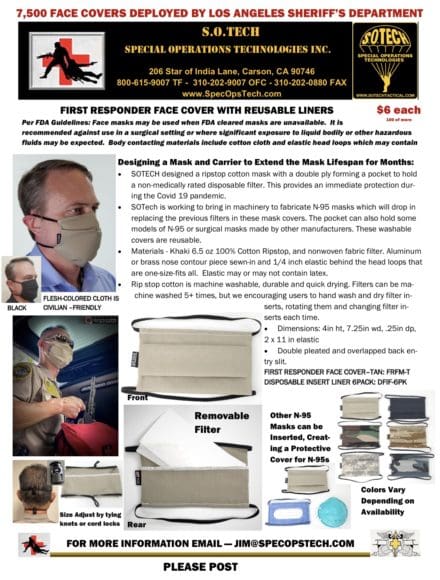
Click here to download pdf
The final advantage is its simplicity and its resultant low cost. At $6 agency price, this is a product designed so that organziations under stress can afford to equip their entire staff, and officers can buy from the website, www.SpecOpsTech.com, to equip their families.
SOTech is manufacturing these First Responder Face Covers as face masks under current FDA guidelines, and they should not be used in surgical environments.
In the midst of the marathon product development project, SOTech staff also proudly produced masks donated to local hospitals and elderly veterans. To learn the story, check out: www.dailynews.com/2020/04/19/how-three-batttle-tested-veterans-declared-war-on-the-coronavirus/amp
VORTEX OPTICS AWARDED OTA FOR THE US ARMY’S COMPETITIVELY SOLICITED NEXT GENERATION SQUAD WEAPON FIRE CONTROL (NGSW-FC) PROTOTYPE PROGRAM
BARNEVELD, Wis. For the last 18 years, innovation has meant everything to Vortex Optics. It’s meant our emergence as a leader in the sport optics industry. It’s allowed us to provide our customers the tools they need to pursue and protect what matters most in their lives.
But starting today, our dedication to innovation means something even more.
We’re honored to announce that the US Army – PM Soldier Lethality awarded Vortex® an agreement to deliver the Next Generation Squad Weapon-Fire Control (NGSW-FC) Production Ready Prototypes for Soldier TouchPoint (STP) evaluations.
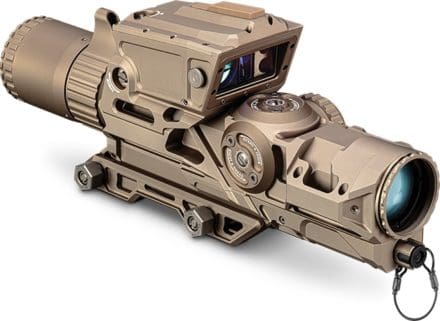
As a direct-view optic, the 1-8×30 Active Reticle™ Fire Control provides everything you’d expect from a variable-power, first focal plane riflescope. When augmented with an overlaid digital display, however, it provides features unheard of in a traditional small arms fire control.
“As a veteran-owned, non-traditional defense contractor, it’s very important to us that we listen to warfighters,” said Sam Hamilton, Chief Technical Officer at Vortex Optics. “When we learned of the soldier’s need for increased lethality out of their squad weapons—combined with the Small Arms Ammunition Configuration (SAAC) study, which proved that advancements in electro-optical fire control had the greatest potential to increase soldier’s lethality—we knew there was an important capability gap we could fill.”
The Vortex Optics 1-8×30 Active Reticle™ Fire Control is built around a revolutionary technology based on many years of internal research and development, along with multiple cooperative development efforts with the Army’s PM-Soldier Weapons group. The end result is Active Reticle™, which has been proven to increase hit percentage and decrease time to engage during US Army Soldier touchpoints over the last two years.
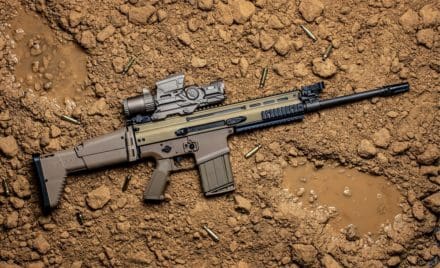
Even in the case of a battery power loss, soldiers are left with an uncompromised 1-8x, direct-view optic and glass-etched reticle exceeding current capability.
Hamilton said, “By combining a unity power 1-8x direct view optic utilizing a first focal plane, etched reticle, a 1km capable laser rangefinder, state of the art on-board ballistic engine, atmospheric sensor suite, and programmable active matrix micro-display overlaid onto the first focal plane, Active Reticle™ delivers a true multi-mission fire control enabling everything from CQB to designated marksmanship at the extents of the NGSW’s effective range.”
For the soldier in the field, that means the freedom to devote their entire focus downrange. Hamilton said, “End-users will no longer need to leave their field of view to consult separate rangefinders or ballistic calculators, slowing them down and compromising their situational awareness.”
Samson Manufacturing is now offering their popular Evolution Series handguards in FDE, including the standard Evolution handguards, the Evolution EX handguards, and the Evolution KeyMod handguards.

All Evolution handguards feature a free-floating AR-15 rail system. Being lightweight and durable the Evolution Series handguards are the perfect upgrade for 3-Gun competition shooting, law enforcement, military personnel, and even the weekend enthusiasts.
Accessory picatinny rails can be added or removed at any of 7 positions around the rail and any place along the length of the tube. The Evolution Series handguards accommodate most piston systems.
The standard Evolution Series and the EX Series include thermal bushings, two (2) 2″ accessory rail kits, one (1) 4″ accessory rail kit and wrenches. The Evolution KeyMod hand guards do not include the accessory rails.
For more information on these, and all of Samson Manufacturing’s products, visit the Samson website.
Morphix Technologies® SafeAir® and ChromAir® colorimetric chemical detection systems are available for purchase through the Amazon storefront.
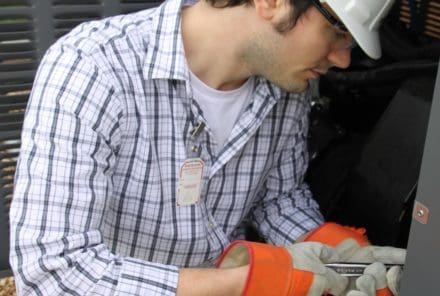
Virginia Beach, Va. (April 2020) – Morphix Technologies®, an innovator in the science of detection devices for dangerous chemicals, would like to remind its customers that its SafeAir® and ChromAir® colorimetric chemical detection systems are available for purchase through its Amazon storefront. Morphix Technologies has maintained its Amazon shop for approximately two years after being approached by the online giant in its effort to broaden its scope to include safety and industrial products.
Morphix Technologies utilizes Amazon to reach customers that were previously unreachable through its current industrial distributor network. For example, Morphix Technologies have seen an increase in small businesses that may not attend industry events, such as trade shows, that it frequents. In particular, Morphix Technologies has seen a growth in the spray foam market. The spray foam market is comprised of many small businesses that work with chemicals, like the type used in home foam insulation or that spray bed liners in trucks. Its SafeAir and ChromAir products are ideal for these companies as their employees work with chemicals and the badges provide simple color changes to identify a chemical in the air.

The SafeAir System offers immediate confirmation of a specific chemical hazard. SafeAir Chemical Detection Badges are available for many different toxic industrial chemicals. The highly sensitive and selective sensor in the SafeAir badge is designed to show a homogeneous and stable color change, which appears as an exclamation point when a particular chemical is present. No calibration or laboratory analysis is needed, making the badges effective, easy-to-use and inexpensive.
ChromAir is designed to detect exposure dose levels to specific toxic chemicals. Because it relies on diffusion, there is no pump to operate. The patented design provides immediate and accurate results throughout the sampling period. The ChromAir chemical exposure monitoring badge offers six exposure levels, with most indicating from one-tenth to two times the Permissible Exposure Limit (PEL) Time Weighted Average (TWA) for an eight-hour work period. To determine the average concentration, users can locate the highest cell with a color change and divide the corresponding dose level (parts per million times hour) by the sampling time in hours.
If you’d like to receive more information about our products, please contact Morphix Technologies toll-free in the US at 800-808-2234 or +1- 757-431-2260 internationally. You can also email sales@morphtec.com.
Visit the website at www.morphtec.com to learn more or join the ongoing conversation on Facebook.
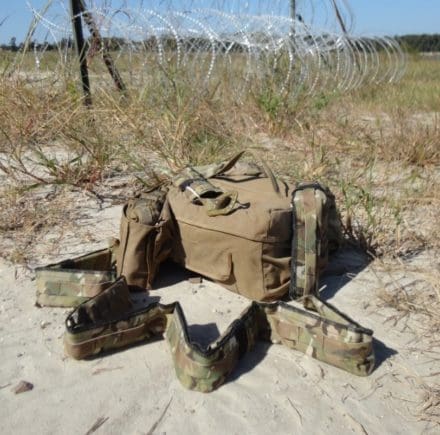
LANDOVER, MD (April 20, 2020) – AirBoss Defense Group (ADG) announced today that the Netherlands Defense Meteriel Organisation (DMO) has placed an initial order of 500 Bandolier Multipurpose Lightweight Explosive Clearing Charge Systems as part of a 5-year program to advance their demolitions capabilities. The contract also provides Bandolier training programs for DMO combat units. The Bandolier is a modern explosive charge designed to enhance soldier survivability and protection during combat operations, providing warfighters with a single, multifunctional device that can effectively clear any obstacle typically encountered on the battlefield in one lightweight, modular package.
The Netherlands is the first North Atlantic Treaty Organization (NATO) country to purchase the Bandolier system. The contract vehicle provides the ability for all 30 NATO member countries to easily procure Bandolier systems and ADG expects additional NATO orders to follow. “The purchase of the Bandolier System marks a milestone event in the demolitions community,” explains Michael McCormack, ADG’s Chief Strategy Officer. “The adoption of this modern, lightweight, highly versatile system by a Tier 1 NATO military power is a major update from the decades old use of standard bulk explosives (C-4) and other purpose-built explosive solutions. This integration will give the Dutch warfighter a significant edge on the battlefield.”
The Bandolier’s patented design bridges the capability gap between larger, complicated breaching charges and standard bulk demolitions. Its unique modular design is light enough for dismounted operations, while remaining flexible enough to meet larger-scale mission requirements. NATO forces can now be supplied with a single, lightweight, easy to use explosive system, capable of performing a wide range of tasks, eliminating the need for multiple mission-specific systems.
For more information, please visit www.adg.com.

Double Tap Surplus has teamed with Bergspitze Customs to produce Pleated Face Masks, featuring a rip-stop outer surface and a softer inner facing fabric.
Offered in three packs consisting of either MultiCam, AOR 2 (NWU Type III) or assorted which randomly contains MultiCam, MultiCam Black, Woodland Tiger Stripe, Desert Tiger Stripe, Six Color Desert, ABU, AOR 2 and others.
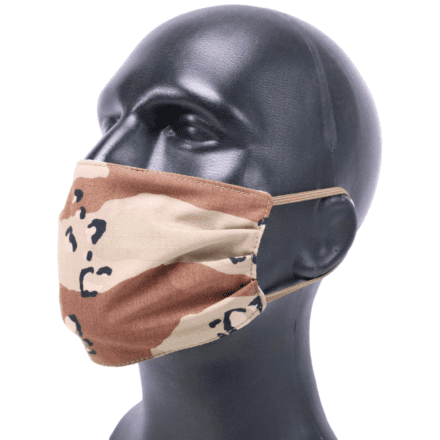
You may choose between elastic loops or paracord ties.
Even better, Double Tap is offering FREE masks to local military (while supplies last) located here in the Tidewater. Just go to doubletapsurplus.com/products/reusable-face-mask-complimentary-for-military. Be advised, this service is made possible by offering one free mask for each three pack sold.
To order your masks, visit doubletapsurplus.com/products/face-mask-3-pack.